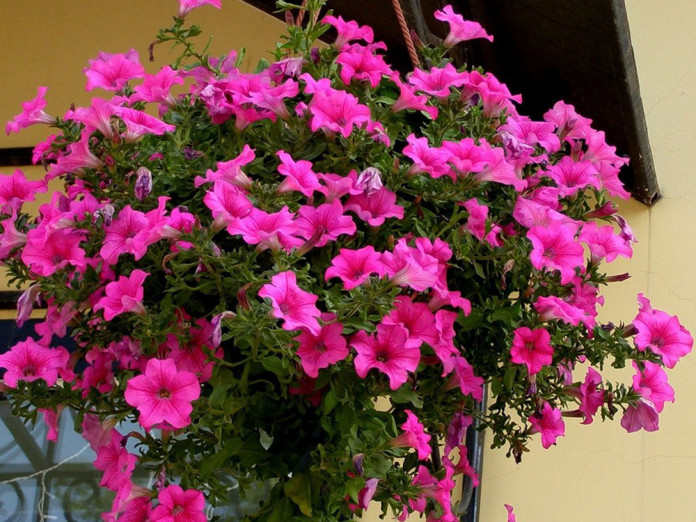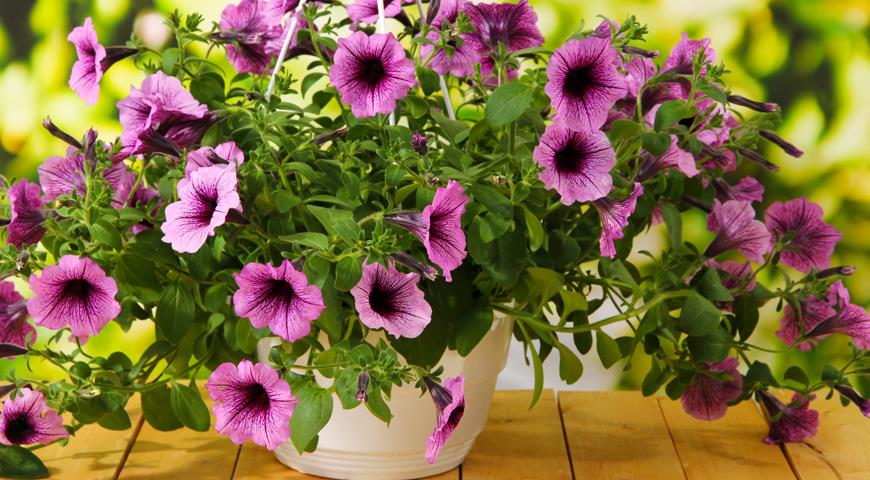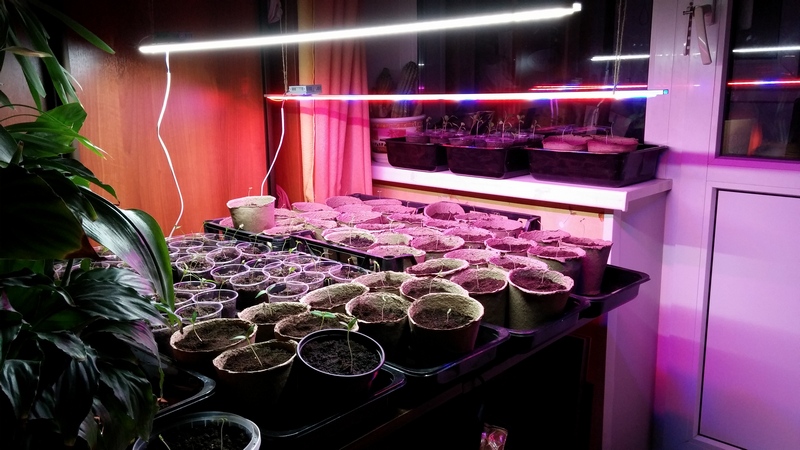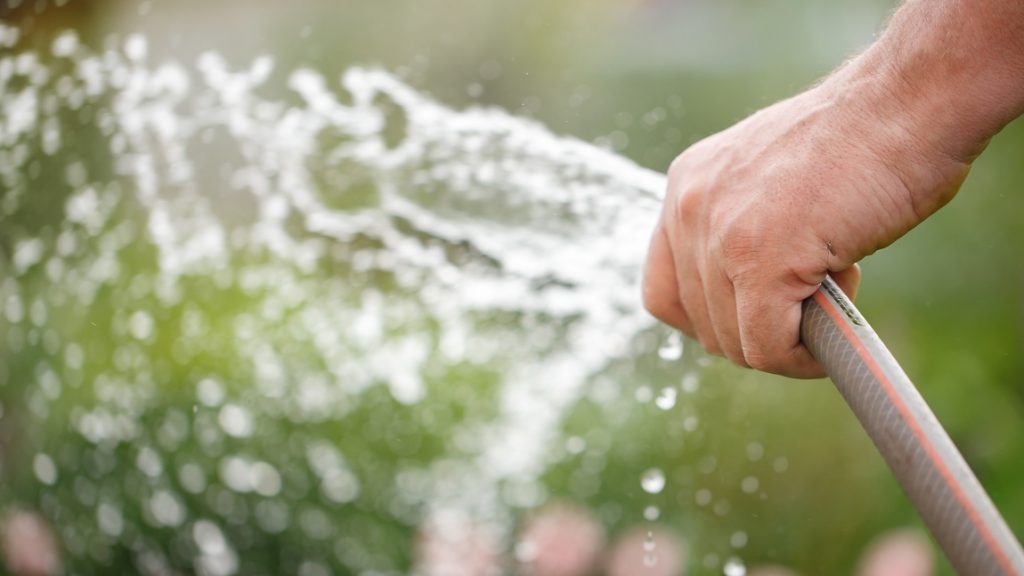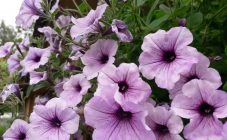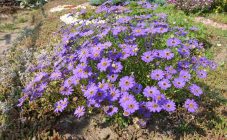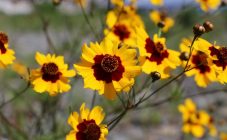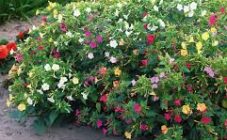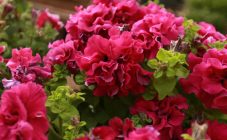Content:
Summer is an amazing time: nature demonstrates a riot of colors and textures of plants. Many people want to see such beauty, so they decorate their backyards, balconies and the territory adjacent to the house with flowers. To do this, it is enough to plant the type and variety of plant you like. The article will focus on ampelous petunia, features of its planting and care to create beauty around.
Petunia ampelous: description and characteristics of varieties
Petunia ampelous is a plant of amazing beauty, has unusual and memorable flower stalks and graceful elongated shoots.
Type description:
- The length of the shoots can vary significantly from 30 cm to 120 cm. During active growth, they fall down without falling apart on the sides.
- Small leaves are observed in young crops, in older petunias they are larger. The leaf plates are slightly pubescent, pleasant to the touch.
- A characteristic feature of ampel varieties is a large number of flowers. This is due to the fact that they are formed in each of the shoot sinuses. The shape is like a bell. The color can be different: from ivory to purple. The petals are bicolor, the color inside is brighter and more saturated.
- This is a light-loving culture, therefore, with a lack of lighting, the green mass will form more actively, and there will be practically no peduncles.
- Possesses good adaptive properties in temperate climates.
- Cold hardiness indicators are average. Tolerates cold snaps and small frosts.
With the help of this flower, you can form living carpets in flower beds, as well as grow in pots. Compliance with the rules of planting and growing will allow you to observe the first flowering in the shortest possible time.
Popular varieties
Ampelous petunia is considered the most common variety. Breeders have bred many varietal species: there are annuals and perennials. They are conventionally divided into 3 more groups:
- varieties with strong and long shoots, the length of which can reach 120 cm;
- varieties, the stems of which are directed upward during growth, and then spread with a carpet;
- varieties with short loops.
They can be grown in hanging pots, capacious flowerpots and balcony boxes. The most common varieties of ampel petunias include:
- Hybrid Ekaterina. Peduncles have an unusual and very rare color - a combination of red, yellow and orange. The diameter of each flower is 5-6 cm.
- The Snow Queen has medium-length stems. During flowering, numerous white inflorescences are formed. They exude a subtle but extremely pleasant aroma.
- Black velvet has an unusual color - a very dark color with tints. The trunk is densely branched, capable of reaching a height of 35 cm.
- Masha is bright and attractive flowers. The stems grow up to 80 cm in length. The leaf plates are formed alternately, are small in size. The flowers are bright pink with a characteristic light yellow vein in the middle.
- Svetlana has long and branched stems. Leaves are small in size, arranged alternately.The flowers are wavy with bright pink veins that visually resemble a funnel.
- Varietal variety Explorer. Unlike other varieties, the length of the shoots of this can reach 1.5 m. Flowers are formed in large sizes, the color can be different.
- Neon roses is a large-flowered variety of ampelous petunia. Flowers of a dark lilac color are formed. Shoots can be up to 35 cm in height.
It is worth paying attention to the fact that it is not so easy to grow terry varieties of ampel petunias at home. This is due to the plant's exactingness to care.
Petunia ampelous and cascading: differences
Petunia is a rather whimsical and wayward plant, and this is not surprising, since its natural habitat is a hot climate with a high level of humidity. But thanks to the work of breeders, every gardener has the opportunity to breed such beauty, since it is much easier to care for modern hybrids.
What are the differences between ampelous and cascading petunias, how to distinguish them from each other without knowing the name? Cascade varieties are semi-ampellous; in the process of development, a stem is formed much thicker than that of congeners. Otherwise, the difference between the species is insignificant.
Agricultural rules
Most gardeners love ampelous and spray petunias. Both are attractive and expressive when in bloom. Ampel varieties are usually grown at home, and bush varieties are more common in summer cottages. However, despite the variety chosen, the plant must be properly cared for.
Growing seedlings from seeds
If the gardener has the opportunity to provide artificial lighting, then petunia can be sown as early as February. Otherwise, it is advisable to wait for March, when the length of daylight hours will increase.
The soil for sowing must be loose and nutritious, have a light structure. To prepare the planting soil, the following composition is required: sand, peat, humus, leaf and / or sod soil.
The top layer of the earth should be as light as possible, so it is recommended to sift it first. Next, a small amount of dry sand must be added to the seed, after which the resulting composition is evenly distributed over the surface of the prepared soil. To accelerate the germination of containers with seedlings, it is recommended to cover them with glass or plastic wrap and place them in a room where the temperature does not drop below 21 ° C.
As a rule, the first shoots can be observed after 1 week. From this moment on, the plant needs special care. Seedlings need to be watered twice a day, sprinkling with water at room temperature from a spray bottle. Also, be sure to ventilate the room. It is almost impossible to grow healthy seedlings without an optimal indoor humidity level.
As soon as the first leaves of the seedlings form, the film or glass can be removed.
It is recommended to transplant in the evening or cloudy weather, and transfer the seedlings to open soil along with the soil from the pots. The optimal size of the planting holes is 10 * 10 cm. After planting, the soil is carefully tamped and mulched with rotted humus or peat. Thanks to this, it will be possible to maintain an optimal level of moisture and protect the crop from low temperatures.
Top dressing and watering
Petunia has high growing requirements, therefore, in the absence of the introduction of fertilizing and rare watering, it will not be possible to grow a lush flowering bush.
Watering should be done daily.Moisture deficiency leads to the development of fungal, viral and infectious diseases. In order for the culture to be provided with all the necessary nutrients, it is worth feeding with special formulations. It is advisable to introduce fertilizers every time during watering.
One of the feeding schemes:
- the first week - watering with water with humates;
- for the next weeks, water the plant with water and potassium sulfate.
Formation of ampelous petunia
Already in mid-July, as a rule, the shoots grow strongly, hang down and require immediate removal. If this is not done, new buds and leaves will be actively formed only at the tops. The flower will simply become unattractive.
Petunia is a unique plant of its kind that combines excellent decorative properties. If a novice florist does not first familiarize himself with all the features of planting and growing a crop, then it will not work to achieve the desired beauty. For beginners, this can be a real challenge, especially if you grow flowers in the open field, trying to equip a flower bed. You can increase the chances of survival by growing the seedling method. Then the planting material will be hardened and strong, which will allow the seedlings to feel comfortable in the beds.
